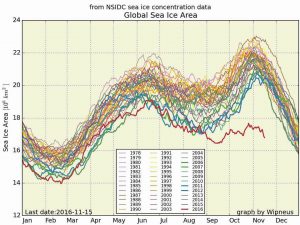I’ve been seeing some interesting and alarming stories this week about extremes in climate.
The Washington Post published a story about a giant reservoir in Southern California that is nearly dry due to the continuing drought there. Remember that So Cal got mainly missed by the El Niño rains that fell last winter. The water is at 7 percent of its normal capacity. Unless they get rain soon, the water is expected to run out by January, eliminating water supplies for a large area. You can read the story here.
In another region far from California, a large lake in China dried up in a matter of weeks due to the extreme drought there. At its largest, Lake Poyang covered an area more than three times the area of Los Angeles; now it’s been reduced to a grassland that locals can walk across. The early arrival of the dry conditions has caused tremendous hardship for rice farmers and local fishermen. You can read about it and watch a video from The Weather Channel here.
The World Meteorological Organization notes that unless we get the coldest end to the year of the 21st century, it will be the hottest year on record, according to a story in The Conversation here. The story also describes all of the extreme weather and the weather- and climate-related disasters we have seen in 2016 so far.
And finally, the graph of the day from the NOAA Snow and Ice Data Center shows the awful decline in the total global sea ice (combining Arctic and Antarctic areas together) in 2016 compared to previous years. Guess which year the red line is? This year both the Arctic and Antarctic sea ice coverage shrunk significantly, in contrast to previous years when the Arctic amount shrunk while the Antarctic grew (albeit at a much lower pace). Perhaps this partially explains the lack of cold air this year over the US (see my blog post from yesterday on the lack of cold weather).
